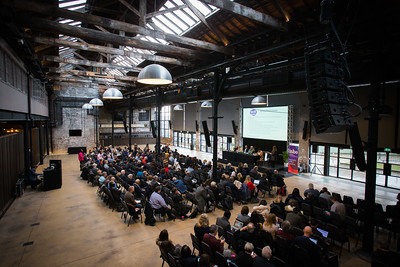ISBE 2019 reflections
Dr Dominic Smith
I am an artist and curator whose practice reflects an interest in the collaborative nature of narrative and lens based practices, digital platforms, digital material culture, Machine Learning, Blockchain technologies and experimental approaches to audience engagement via digital means and liveness. I have a PhD that explores participatory art in relation to Open Source software development and have developed a number of art and technology based projects in the UK and Europe.
I attended the ISBE symposium primarily to deliver a talk ‘Social Justice through the Digital Economy; ‘Fairer Futures for Business and Workforce’. People, Innovation and Regional Development, North of the Tyne.’ With Dr Sharon Wilson from Northumbria University.
The main consideration for me when choosing which talks to attend was to gain a better understanding of current language around what is being termed the gig economy. I was also interested in the business sectors approach to new technologies and the language that surrounds this. As a result the sessions I attended included ‘Freelancing, Solo Self Employment and Gig Working Economy’, ‘Technology Entrepreneurship’ and ‘Creative Industries Entrepreneurship’.
An interesting discussion arose during the presentation by Małgorzata Skrzek-Lubasińska and Radosław Malik at the ‘Gig Working Economy’ session. This took the form of a poster presentation more than a talk, but interestingly this allowed for more time for feedback and discussion around the protection of worker’s rights in an increasingly aggressive, digital platform managed work environment. It was interesting to hear from them at an early stage in their research and many of the delegates shared their concern for individual protections for those working in the gig, or ‘on demand’ labour markets. The subject turned to the large impenetrable end user agreements that workers sign up to in order to use the platforms. There was discussion around the similarity between these agreements and software licenses and the point was raised that perhaps rights could be protected through the development of a universal open source style license designed with greater equity in mind. It was interesting to ponder these issues as someone who has had long spells of freelance work in the creative industries where this gig style work has been commonplace for as far back as I can remember. The big difference is that this is an industry that expects a certain degree of skill and experience from the people they recruit and in turn this enables a greater degree of arbitrage for those working in this way.
Whilst as stated, my work and research is focused upon the creative sector, I have a keen interest in the impact that new technologies have upon the arts, and particularly how the arts can help us understand the social implications of new technologies. I attended the Technology Entrepreneurship session with this in mind. Kisito Futonge Nzembabie delivered an interesting presentation ‘Enacting Pure Digital Entrepreneurship – Mechanisms Driving New Venture Creation’. This talk was focused upon EdTech which is not my field. But it was interesting to hear him talk about Digital Artefacts as ‘Quasi Objects’ and relate this to mobile apps and software. This in some respects has been an ongoing matter for debate in the arts for some time, and often digital artforms can be described as de-materialised as opposed to the material nature of traditional artforms (such as painting or sculpture). But I can see why this term was used in this instance when one is considering their value both in terms of the real world, industry based costs of production compared to the negligible cost of reproduction and distribution.
The last presentations I attended were part of the Creative Industries Entrepreneurship session. The first talk of this session was ‘Unpacking Narratives of Entrepreneurship for Creative Workers’ by Paul Richter, Fiona Whitehurst, Gary Wilkin. Delivered by Paul Richter. As an artist who has been involved in a number of projects that were referred to in this talk it was interesting to see how they were gathering data in a way that would be of use to policy makers and it was refreshing to hear a note of caution regarding the ongoing expectation that it is the artists role to innovate in these environments. I concur that this is an ongoing expectation and a narrowing of our skills and role in society to fit a pre-determined set of expectations. I will be following this research and hope to keep in touch with them as their work unfolds. It was well matched with the presentation that followed it by Sue Hayton, Stephen Dobson. Delivered by Stephen Dobson – ‘Reflections on Creative Labs: The Leeds Creative Labs programme’. It was particularly interesting to hear them question how fit for purpose the modern workplace is and to then talk about what they offer in terms of the partnerships they build with artists and how they support the outcomes of this work. As a slight aside, this room layout for this final session was interesting. Rather than having everyone arranged in rows, the chairs were arranged in a less formal arrangement around the room. It is a small detail, but I do believe it had a positive impact upon the group dynamics of this session, creating a friendly open environment, and the group discussions flowed very well as a result.
My overall impression of this symposium was a positive one. As a freelancer it is often very hard for me to make the time for my own personal development and to take time to consider the work that I do and the work I support from an economic perspective was incredibly valuable. Thank you to all the conference organisers and a particularly big thank you to Dr. Stefania Romano and Dr. Charlotte Carey for running a brilliant and insightful session on Creative Industries and for their support throughout my engagement in this symposium.




